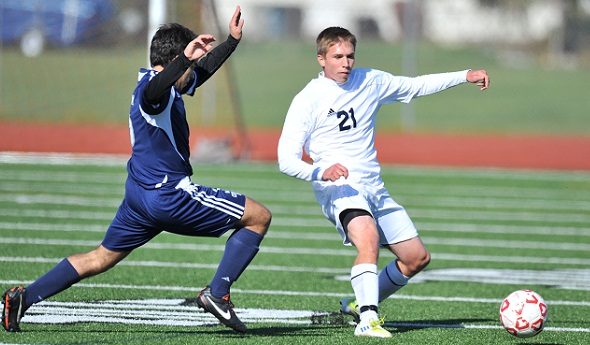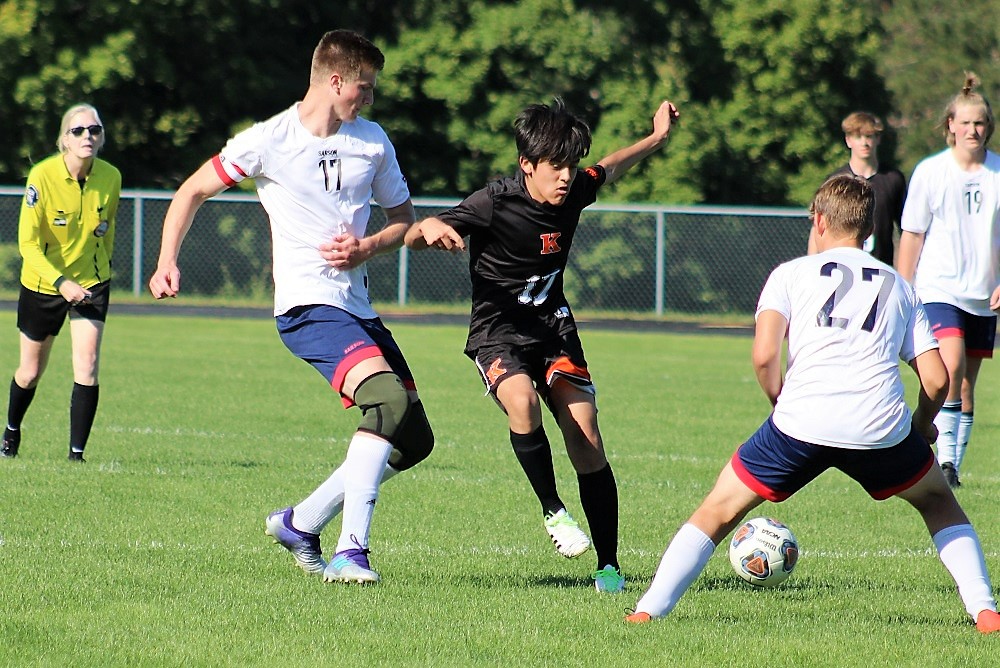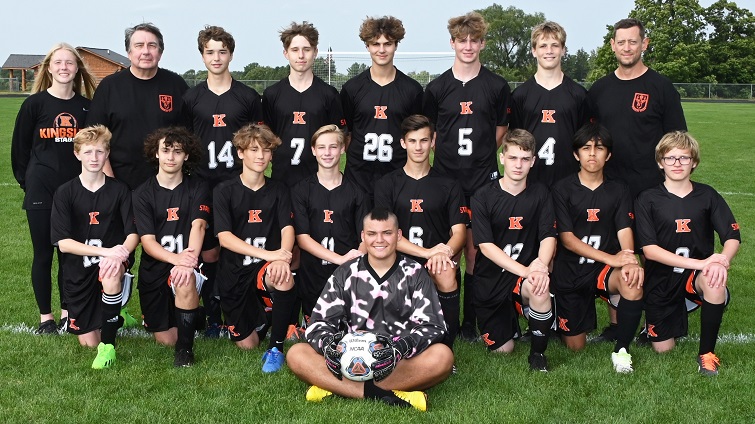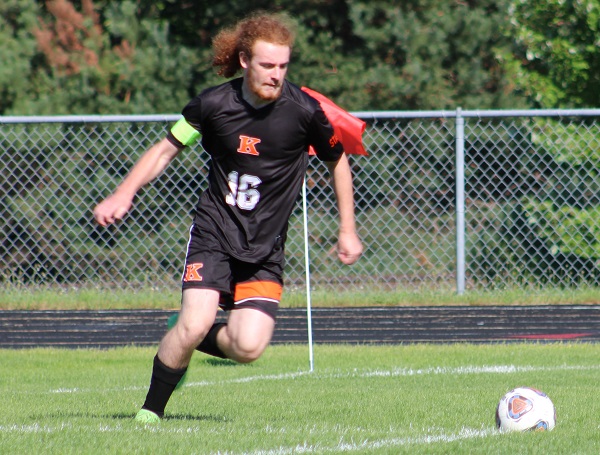
Finals Preview: The Golden Goal
November 2, 2012
There's a definite Grand Rapids feel to this weekend's MHSAA Boys Soccer Finals.
The higher-ranked teams in all four championship games hail from that city and its near neighbors, and have combined for six MHSAA championships. Their opponents have combined for two titles, and two of the four will be playing in their first Finals on Saturday.
All four games can be watched live at MHSAA.tv. See the schedule below:
- Division 1: East Kentwood vs. Grand Blanc, 3 p.m. at Troy Athens
- Division 2: Hudsonville Unity Christian vs. Petoskey, 3 p.m. at East Kentwood Crestwood Middle School
- Division 3: Grand Rapids South Christian vs. Williamston, noon at East Kentwood Crestwood
- Division 4: Grand Rapids Covenant Christian vs. Hamtramck Frontier International, noon at Troy Athens
Read on for background on all eight teams, including their most impressive wins this fall and some of the players who could make the biggest impacts on the final day of the season. (Statistics below do not include those from Wednesday's Semifinals.)
DIVISION 1
EAST KENTWOOD
Record/rank: 21-1-4, No. 1
Coach: John Conlon, 13th season (253-38-22)
League finish: First in O-K Red.
MHSAA championship history: Three MHSAA titles (most recent 2010).
Best wins: 3-1 and 2-1 (District Semifinal) over No. 2 Rockford, 2-1 over No. 5 Brighton (Regional Final), 4-0 over Division 2 No. 2 Ada Forest Hills Eastern
Players to watch: Charlie Constantino, sr. M (9 goals, 11 assists); Tyler Moorman, sr. D (10 G/4 A); Josh Hagene, sr. M (8 G/12 A), T.J. Ifaturoti, sr. F (16 G/7 A).
The scoop: East Kentwood has won at least 20 games for the seventh time over the last eight seasons and has been the dominant program in Division 1 of late with MHSAA championships three of the last five seasons. Constantino is considered one of the top players in Michigan high school soccer, and he’s one of 11 seniors on the team. East Kentwood’s only loss was 4-3 to No. 8 Portage Northern.
GRAND BLANC
Record/rank: 16-6-2, unranked
Coach: Greg Kehler, 14th season (217-62-29)
League finish: Second in Kensington Lakes Activities Association West
MHSAA championship history: Class A runner-up 1987
Best wins: 5-3 over No. 4 Rochester Hills Stoney Creek (Regional Semifinal), 4-3 over Lake Orion (District Final).
Players to watch: Chris Sullivant, sr. M (4 G/8 A); Dominic Mastromatteo, sr. F (11 G/6 A), Nick Berklich, jr. F (16 G/2 A).
The scoop: Kehler has 429 wins total between Grand Blanc’s boys and girls teams and took the latter to the 2004 Finals. This run has been a little more unexpected, especially after graduating Mr. Soccer Zach Carroll this spring. But the Bobcats are making good on lessons learned during nine games decided by a goal during the regular season, and have won three one-goal games plus another by two in overtime during the tournament. Sullivant is a four-year standout, and Mastromatteo in particular has been finding the net often during the postseason surge.
DIVISION 2
HUDSONVILLE UNITY CHRISTIAN
Record/rank: 24-2, No. 3
Coach: Randy Heethuis, 19th season (353-62-29)
League finish: Tied for first in O-K Green
MHSAA championship history: Two MHSAA titles (most recent 2009), four runner-up finishes.
Best wins: 3-0 over No. 2 Ada Forest Hills Eastern (Regional Semifinal), 2-1 over No. 1 Spring Lake (Regional Final), 2-0 over No. 7 Holland, 2-0 over Division 3 No. 2 Grand Rapids South Christian, 4-0 over Division 4 No. 10 Muskegon Western Michigan Christian.
Players to watch: Jared Timmer, soph. M (6 G/15 A); Jake Love, sr. F (12 G/13 A); Stephan Hooker, sr. M (19 G/8 A); Joe Honderd, jr. F (13 G/6 A); Nick Woldyk, sr. GK (0.76 GAA, 9 SHO).
The scoop: The Crusaders are the reigning runners-up from Division 3 and certainly earned their way here by beating the only teams ranked ahead of them in the most loaded Regional in any division. Unity Christian has shut out four of six opponents during the tournament and 14 total this season. The losses came on opening night to Division 1 No. 8 Portage Northern and to Holland in their second game against each other this fall.
PETOSKEY
Record/rank: 17-8-2, unranked
Coach: Zach Jonker, third season (35-26-9)
League finish: Third in Big North Conference
MHSAA championship history: Two MHSAA titles (most recent 2008), two runner-up finishes.
Best wins: 1-0 (OT) over No. 4 East Lansing (Regional Final), 3-1 over No. 9 Bloomfield Hills Cranbrook-Kingswood (Semifinal), 2-0 and 2-0 over Division 3 No. 7 Elk Rapids.
Players to watch: Louis Lamberti, sr. F (12 G/5A), A.J. Hoffman, sr. F (10 G/6 A), Evan Altman, sr. M (8 G/8 A), Drew Smith, sr. GK (0.92 GAA, 13 SHO).
The scoop: The Northmen loaded their schedule with tough competition early, and it’s paid off at the end. Their losses are nearly as impressive as their wins: to Division 1 honorable mention Warren DeLaSalle and No. 4 Rochester Hills Stoney Creek and to Division 2 No. 8 Bloomfield Hills Lahser during a 1-5-1 start. Petoskey is 16-3-1 over its last 20. The team also finished MHSAA runner-up in 2009 before making District exits the last two seasons.
DIVISION 3
GRAND RAPIDS SOUTH CHRISTIAN
Record/rank: 20-2-3, No. 2
Coach: Jason Boersma, second season (36-7-5)
League finish: First in O-K Gold
MHSAA championship history: MHSAA champion 2010, runner-up 2007.
Best wins: 2-0 over No. 3 Whitehall, 1-0 over No. 9 Grosse Ile (Semifinal).
Players to watch: Erik VerHoef, sr. GK (0.43 GAA); Kyle Doornbos, sr. D/M (6 G/12 A); Marlon Bykerk, jr M/F (14 G/13 A); Cody Kok, jr. M (13 G/6 A).
The scoop: The 17 shutouts by VerHoef and Zach Medendorp rank among the most in MHSAA history for one season, and total the team has given up only 10 goals. Seven Sailors have scored at least six goals, with senior Alex Klunder adding his ninth of the season in Wednesday’s Semifinal to push the team into the championship game. South Christian’s only losses came to Division 2 No. 2 Forest Hills Eastern and No. 3 Unity Christian.
WILLIAMSTON
Record/rank: 19-7-1, honorable mention
Coach: Brent Sorg, eighth season (106-69-12)
League finish: Second in Capital Area Activities Conference White
MHSAA championship history: Has never appeared in an MHSAA Final.
Best wins: 3-1 and 2-1 (SO, Semifinal) over No. 7 Elk Rapids, 2-0 and 3-2 (Regional Semifinal) over No. 8 Freeland, 2-0 over No. 10 Frankenmuth (Regional Final), 2-1 over Division 4 No. 1 Lansing Christian, 6-2 over Division 4 No. 9 Ann Arbor Greenhills.
Players to watch: Hunter Lyle, jr. M (16 G/6 A); Zach Sundin, sr. F (19 G/6 A), Ross Needler, sr. M (17 G/16 A), Phil Erickson, sr. M (10 G/3 A).
The scoop: Williamston has won nine of its last 10 after also stacking the schedule early. The Hornets fell early to ranked Division 2 teams Holland, East Lansing and Haslett, plus Division 3 No. 5 Detroit Country Day and tied Division 1 honorable mention Birmingham Brother Rice during the first half of the season. But Williamston has been building toward this type of run with five straight seasons of either increasing or equaling the previous year’s win totals. This season’s District title was its second straight and fourth under Sorg.
DIVISION 4
GRAND RAPIDS COVENANT CHRISTIAN
Record/rank: 19-4-1, No. 8
Coach: Mike Noorman, ninth season (106-64-11)
League finish: First in River Valley Conference
MHSAA championship history: Has never appeared in an MHSAA Final.
Best wins: 2-1 over No. 10 Muskegon Western Michigan Christian, 2-1 over No. 2 Kalamazoo Hackett Catholic Central (Regional Semifinal), 2-0 over honorable mention Leland (Semifinal).
Players to watch: Jordan Van Oostenbrugge, sr. M/F (16 G/11 A); Corbin Prince, jr. F (16 G/12 A); Austin Brower, jr. GK (1.23 GAA/11 shutouts).
The scoop: Combined, Van Oostenbrugge and Prince have scored more than half of their team’s goals and more than the Chargers have given up this season. The District title was Covenant Christian’s third in five seasons and the team has increased its win total in each of the last four. The Chargers have 11 seniors, but also start two talented sophomores.
HAMTRAMCK FRONTIER INTERNATIONAL
Record/rank: 17-2, unranked
Coach: Nasser Algahim, third season (51-4)
League finish: Does not play in a conference.
MHSAA championship history: Has not appeared in an MHSAA Final.
Best wins: 4-2 over No. 4 Birmingham Roeper (District Semifinal), 2-0 over No. 9 Ann Arbor Greenhills (Regional Semifinal), 1-0 over No. 1 Lansing Christian (Regional Final), 2-0 over No. 5 Genesee Christian (Semifinal).
Players to watch: Baleegh Algahim, sr. F, (23 G/10 A); Habeb Ghaleb, soph. M, (21 G/8 A), Mujeeb Nahshal, jr. M, (5 G/15 A), Mohammed Alfahad, sr. M (5 G/11 A); Ammar Abdullah, soph. GK (0.78 GAA)
The scoop: Frontier International is in just its third season as a program, but made the Division 4 Semifinals in 2010 and returned to Regionals last fall. Playing as an independent, the Knights faced a schedule loaded with bigger schools from all over the Detroit area, with losses only to Pontiac Notre Dame Prep and Berkley. Although unranked, no team aside from Unity Christian in Division 2 has knocked out as impressive a group of ranked opponents during the tournament this fall.
PHOTO: Hudsonville Unity Christian senior Logan Walters (21), here in last season's Division 3 Final against Detroit Country Day, will try to help the Crusaders to their second MHSAA title in three years.

Records May Not Show It - Yet - But Kingsley Soccer Improving, Ready to Rise
By
Tom Spencer
Special for MHSAA.com
October 21, 2022
Kingsley did not go on unnoticed this fall in Northwest Conference soccer play.
 In fact, many took considerable notice of the Stags.
In fact, many took considerable notice of the Stags.
And, the coaches of the league’s top teams are looking for even bigger things ahead from Kingsley. Quite, frankly, they’re hoping it comes to fruition for their own teams’ sakes.
“It’s always beneficial to have a solid conference – as it helps teams prepare for playoffs,” said Rob Sirrine, coach of this year’s league title winner, Leland. “We expect them to improve in the next few years.
“Kingsley has had a rough go of it the last few years – not unlike other schools in our conference that also have football teams,” he continued. “I think they have some potential based on the coaches they have brought in and volunteers that are helping out the program.”
Second-year Kingsley head coach Tim VanWingerden welcomed Mike Alanson as a volunteer varsity assistant coach and two middle school coaches — Bert Baker and Lars Mitchell — this fall. Baker and Mitchell had kids on the Stags’ middle school squad this season.
League opponents, including the varsity coaches, noted big differences already.
Buckley coach John Vermilya, whose Bears finished second this year after winning the crown a year ago, echoed Sirrine.
“Kingsley has shown incredible resilience over the last three seasons,” Vermilya said. “This season they bounced back with an influx of young players, and you can see their growing tactical awareness along with technical ability.”
Youth soccer is growing in the Kingsley community as well, adding to the excitement. In fact, VanWindergen has two boys —Ted, 10, and Gunnar, 9, playing in the youth program. Tabatha VanWingerden, wife of the Stags’ head coach, is the coach of the U-12 team.
 Mitch Miggenburg, Kingsley’s athletic director, is pleased to see the growth in numbers as the Stags move through “a 3-5 year” plan to become more competitive in soccer and cross country. He’s hoping those sports can find success similar to that of the Stags’ football team.
Mitch Miggenburg, Kingsley’s athletic director, is pleased to see the growth in numbers as the Stags move through “a 3-5 year” plan to become more competitive in soccer and cross country. He’s hoping those sports can find success similar to that of the Stags’ football team.
Kingsley is 6-2 on the gridiron and looking ahead to the football playoffs again. The Stags are fielding a full squad of cross country runners this fall after some lean years.
With an enrollment of well under 500, Kingsley has been able to involve 62 boys in football, 10 in cross country and 17 in soccer. Miggenburg noted cuts had to be made to the school’s co-ed middle school team this fall.
“I think we’re headed in the right direction,” Miggenburg said. “If you look at our record, you might not see it.
“This is not something that is going to happen overnight,” he continued. “In order for us to develop the way we want to develop, we’ve got to put some time in outside the season. And we have some coaches willing to help and do that, and it will only benefit us in the future.”
The Stags have not won a game the last two seasons, but VanWingerden believes success, as defined by wins, is right around the corner. He knows his team has shown moments of brilliance in every contest before the goals mounted against the Stags.
VanWingerden and Kingsley have been praised for outstanding sportsmanship by referees, opposing players and coaches.
Other bright spots in 2022 included outstanding play by freshman goalie Nate Lamie and stellar defense by senior captain Zakkeus Bedford. The Stags will have to overcome the loss of Bedford, their only senior this year, who played with tremendous drive and was the leader on the field.
But, they should return rest of the squad hungry for wins. And, they’ll add some solid incoming freshman players.
 “I think next year is going to be a big turnaround,” VanWingerden predicted. “So the next two, three years, we’re going to start turning some heads.”
“I think next year is going to be a big turnaround,” VanWingerden predicted. “So the next two, three years, we’re going to start turning some heads.”
Despite not experiencing wins either of the last two seasons, the Stags have enjoyed playing soccer.
“There is a camaraderie there with these kids I just can’t quite put my finger on, but it’s part of what binds them better, facing that adversity on a regular basis and getting though it together as a team,” VanWingerden said. “They’ve come to practice the next day determined to work hard and try to improve little by little.
“The common goal to get better pulls them together and gives them a determination that is hard to find.”
Many conference games this year were played 9 vs. 9 or 10 vs. 10 per conference agreement. Benzie Central and Glen Lake played with fewer than 11 players in every contest this season. Benzie Central, Glen Lake, Kingsley and Suttons Bay all compete in cross country, football and soccer. Leland and Buckley do not field football squads.
The Comets won a District championship 1-0 on Thursday at Suttons Bay. The Bears are playing in a District Final on Saturday in Lakeview. Kingsley’s 0-19 season ended with a Division 3 District-opening loss to Boyne City last week.
The Stags have already begun working on next year. Offseason plans include drop-in soccer and participation in a newly-developed strength and conditioning program.
“The program is not going to move forward unless we put in a ton of work,” VanWingerden acknowledged. “We’ve had glimpses into what we could be if we did it on a regular basis.
“It is really encouraging.”
 Tom Spencer is a longtime MHSAA-registered basketball and soccer official, and former softball and baseball official, and he also has coached in the northern Lower Peninsula area. He previously has written for the Saginaw News, Bay County Sports Page and Midland Daily News. He can be reached at [email protected] with story ideas for Manistee, Wexford, Missaukee, Roscommon, Ogemaw, Iosco, Alcona, Oscoda, Crawford, Kalkaska, Grand Traverse, Benzie, Leelanau, Antrim, Otsego, Montmorency, Alpena, Presque Isle, Cheboygan, Charlevoix and Emmet counties.
Tom Spencer is a longtime MHSAA-registered basketball and soccer official, and former softball and baseball official, and he also has coached in the northern Lower Peninsula area. He previously has written for the Saginaw News, Bay County Sports Page and Midland Daily News. He can be reached at [email protected] with story ideas for Manistee, Wexford, Missaukee, Roscommon, Ogemaw, Iosco, Alcona, Oscoda, Crawford, Kalkaska, Grand Traverse, Benzie, Leelanau, Antrim, Otsego, Montmorency, Alpena, Presque Isle, Cheboygan, Charlevoix and Emmet counties.
PHOTOS (Top) Kingsley’s Rolando Torres works to gain possession against Traverse City Bulldogs’ Tyler Ritola (17), Jonathon Scott (27) and Syrus Ritola (19), as Josephine Arrowood officiates. (Middle) This fall’s Kingsley soccer team. (Below) Zakkeus Bedford lines up a kick this season. (Photos courtesy of the Kingsley athletic department.)

